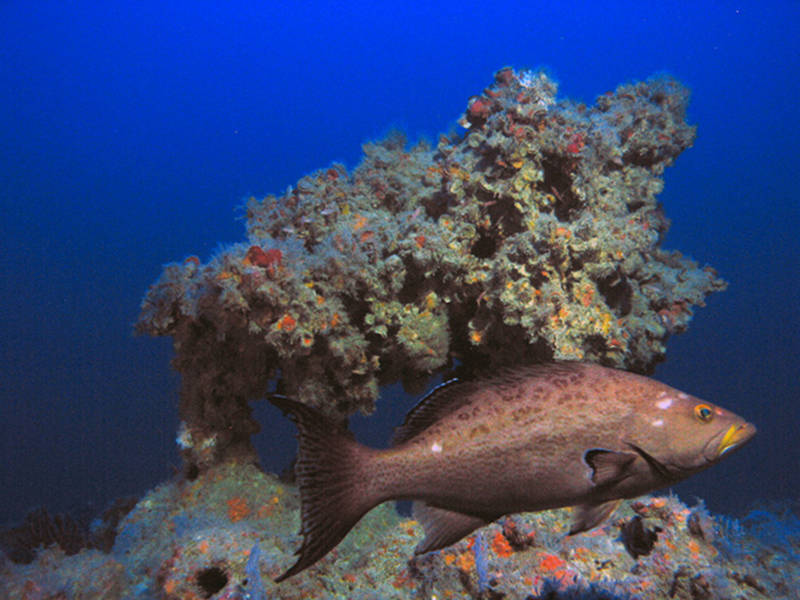
The essays below will help you to understand the goals and objectives of the mission and provide additional context and information about the places being explored and the science, tools, and technologies being used.

Deep reefs, referred to as mesophotic coral ecosystems, can be found from 100-330 feet in the eastern Gulf of Mexico. Pictured is a scamp grouper at 320 feet off the Dry Tortugas. Image courtesy of the Cooperative Institute for Exploration, Research & Technology. Download image (jpg, 88 KB).
By Robert Cowen, Ph.D., Director and Project Lead - Hatfield Marine Science Center, Oregon State University
Kimberly Puglise, Oceanographer and Project Federal Program Officer - NOAA’s National Centers for Coastal Ocean Science
August 14-28, 2014
The Coral Ecosystem Connectivity 2014: From Pulley Ridge to the Florida Keys expedition is funded by NOAA’s National Centers for Coastal Ocean Science and Office of Ocean Exploration and Research, in partnership with NOAA’s Office of National Marine Sanctuaries, National Marine Fisheries Service’s Southeast Regional Office, and Gulf of Mexico Regional Collaboration Team.
The project is led by the University of Miami and represents a collaboration of over 35 scientists at 11 different universities pooling their expertise with state and federal agency scientists through NOAA’s Cooperative Institute for Marine and Atmospheric Studies at the University of Miami in coordination with the Cooperative Institute for Ocean Exploration, Research, and Technology at Florida Atlantic University. This is the project’s third field season and the second highlighted on the Ocean Explorer website; see the Coral Ecosystem Connectivity 2013 expedition to read about last year’s field season.
The project is focused on investigating the role that the relatively healthy deep, mesophotic reefs of Pulley Ridge (off the southwest coast of Florida) may play in replenishing key fish species, such as grouper and snapper, and other organisms in the downstream reefs of the Florida Keys and Dry Tortugas. Because of the well-documented decline of Florida’s reefs, it is important to identify, protect, and manage sources of larval reef species that can help sustain Florida’s reef ecosystems and the tourism economy that depends on it.
A unique aspect of our project is a Stakeholder Advisory Board, a collaboration of federal, state, and nongovernmental stakeholders that are helping to guide outputs and ensure their utility for resource managers.
The goal of this study is to not only provide a better understanding of the underlying processes that regulate Pulley Ridge and whether Pulley Ridge helps sustain the coral reef communities in the Florida Keys and Dry Tortugas, but also help determine if the area would benefit from further protection.
The coral reef ecosystems of the southeast United States provide habitat, food, and shelter to hundreds of species of fish and invertebrates. Their economic role in supporting commercial fisheries, tourism, and recreational industries is also considerable. In addition to their aesthetic value, coral reefs provide structural buffers from storms and currents along the highly populated southeast Florida coast.
Observations of relatively healthy mesophotic reefs on Pulley Ridge have opened up questions as to the ecological role that these reefs may play in the replenishment of shallow and other mesophotic coral ecosystems, such as in the Florida Keys and Dry Tortugas. In an era of rapid coastal ocean changes, it is important to understand the degree of connectivity between Pulley Ridge, a comparatively healthy coral ecosystem, and other coral ecosystems located downstream.
NOAA's National Centers for Coastal Ocean Science
By Robert Cowen, Ph.D.
This is the third year of a five-year study to investigate the role that the mesophotic reefs of Pulley Ridge (off the southwest coast of Florida) may play in replenishing key fish species, such as grouper and snapper, and other organisms in the downstream reefs of the Florida Keys and Dry Tortugas.
Read moreBy Robert Cowen, Ph.D.
Understanding the factors that determine where mesophotic reefs are located, and distances over which species living within such environments disperse and therefore ‘connect’ populations, are of great interest to marine scientists and resource managers alike.
Read moreBy Michael Studivan
In June 2014, divers participated in the third research cruise to Pulley Ridge and second to the Dry Tortugas to collect samples for genetic analyses. This June cruise was one of two cruises that make up the Coral Ecosystem Connectivity 2014 expedition.
Read moreBy Ryan Smith, Villy Kourafalou, and Arnoldo Valle-Levinson
Ocean currents around South Florida drive important physical connectivity between the coral reefs of Pulley Ridge, the Dry Tortugas, and the Florida Keys. Two or more marine ecosystems can be physically connected when water is transported quickly from one location to the other, with little or no change in the water’s properties along the way.
Read moreBy Joshua Voss
Each summer, corals release eggs and sperm in a marvelous coordinated spectacle that gives rise to countless new coral larvae. But do those offspring stay close to home, move to a nearby neighborhood, or perhaps even travel hundreds of miles before settling in a new reef location?
Read moreBy Kimberly Puglise
The term “coral” conjures up visions of warm, tropical waters, or, as of late, the cold dark depths of the ocean where not a ray of sunlight penetrates. Found between these two visions is a relatively unknown and poorly understood depth realm referred to as the mesophotic zone – ‘meso’ for middle and ‘photic’ for light.
Read moreBy Stephanie Farrington and John Reed
Pulley Ridge is the deepest known photosynthetic coral reef off the continental U.S. Located in the Gulf of Mexico; it lies approximately 66 kilometers west of the Dry Tortugas at the far end of the Florida Keys. Originally discovered in 1950, Pulley Ridge is approximately 300 kilometers in length and 15 kilometers wide.
Read moreBy Sean Morton and Beth Dieveney
Greater scientific understanding of Pulley Ridge’s environmental conditions and a species-specific understanding of its ecological connection to the Florida Keys will help determin whether the boundaries of the Florida Keys National Marine Sanctuary should be expanded to include Pulley Ridge.
Read more